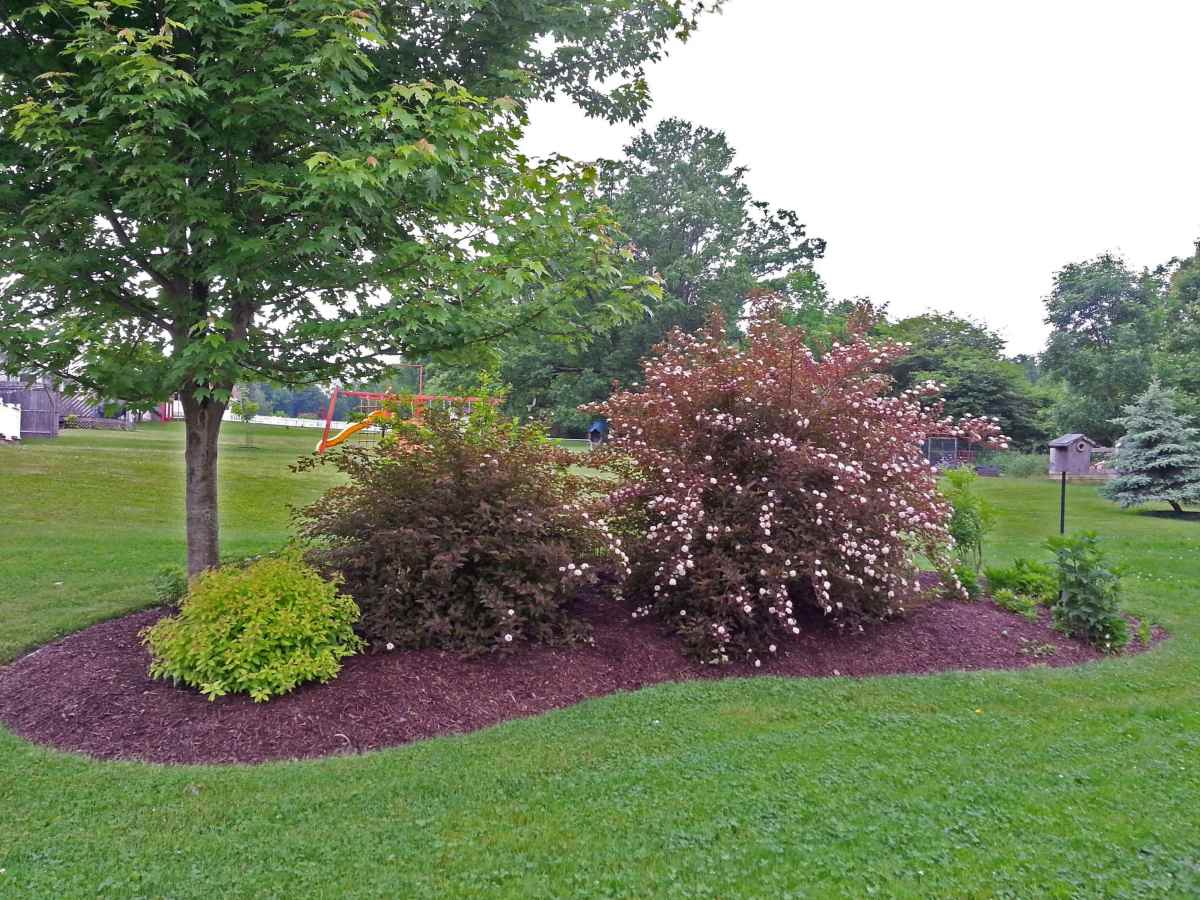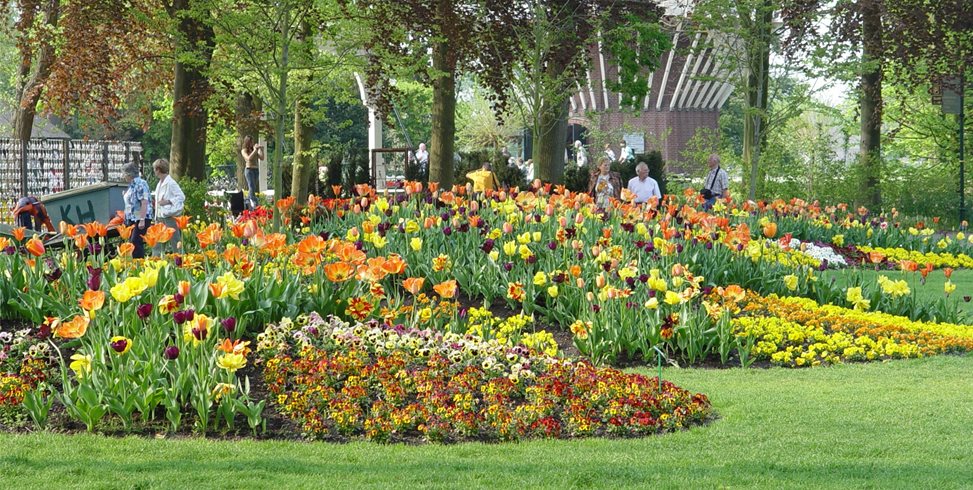Tips For Making Landscape Mounds And Berms

Landscape mounds and berms are a great way to add interest to your yard and landscape. They’re straight forward to build if you follow these simple design guidelines.
What is a Berm?
Berms are raised mounds of soil, dirt, or buried material. Berms adorned with appropriate shrubs, trees, or flowers are used for a variety of purposes, including providing seclusion, acting as a moderate windbreak, and gathering light and shade for plants to thrive, such as flowers or vegetation with striking colours like reds or purples. They can also block and redirect foot traffic. They can add aesthetic value when displaying other items such as sculptures and large natural stones that are visually appealing from a variety of angles.
Berms are an important and frequently underestimated solution for managing water runoff on steep slopes. These specially designed mounded structures serve multiple functions in controlling the flow of water and preventing erosion.
To start with, berms are carefully constructed to seamlessly integrate into the surrounding landscape and blend with the natural contours of the slope. Their rounded and linear shapes allow them to effectively intercept and redirect the flow of runoff water. By strategically placing berms along the slope, they create barriers that slow down the movement of water, giving it more time to infiltrate into the ground and reducing the risk of erosion.
Additionally, berms are often accompanied by swales, which work in conjunction to further enhance their effectiveness in managing runoff. Swales are shallow ditches that run parallel to the contour lines of the slope. They are designed to capture the diverted water from the berms and provide a channel for it to slowly and evenly flow along the slope. This allows the water to be absorbed by the soil more effectively, preventing excessive runoff and allowing for better water infiltration.
By using berms in combination with swales, the overall effectiveness of controlling runoff on steep slopes is significantly improved. The berms serve as physical barriers to slow down and redirect the flow of water, while the swales act as conveyors, guiding the water along the slope at a controlled pace, allowing for optimal absorption.
Overall, berms are a valuable tool in slowing and directing runoff on steep slopes. By harnessing their specific design and combining them with swales, they provide an effective means of managing the flow of water, preventing erosion, and promoting better water infiltration into the soil.
Berm Ideas
Here a few photos that we like.



Landscape Mounds and Berms Design
A landscape designer should plan the design of a mound or berm before constructing it. You can also create a design for yourself. Always consider the overall purpose of the mound as well as the drainage patterns in your landscape in advance. A spill containment berm could be one of the “purposes.” A garden berm or mound should be four to five times longer than it is tall, gradually flowing out into the surrounding landscape.
The majority of landscape berms are 18–24 inches tall. The design can have multiple peaks to add interest as well as shape to serve its purpose. Most are given a curved or crescent-shaped shape, which is preferable and looks more natural.
Add Lighting and Design Ideas to Your Plan
If you want to further add interest to your yard and landscape, you can choose to decorate your yard with custom outdoor neon signs. Using neon signs at night can also enhance the beauty and interest of your yard. If you need a more personalized sign, you can have a custom outdoor neon signs made to fit your needs. This can make your yard look even more unique.
Outdoor neon signs are also waterproof. You can use them without having to receive them inside the house when it rains. You can also bring outdoor neon signs when you want to go on a picnic in the countryside. This will make your picnic experience better. Let’s customize neon lights together.
Build A Berm Or Landscape Mounds
Berms are often constructed using fills such as plant debris, sand, asphalt, soil, or rubble. Use the fill materials to fill the major part of the berm, forming its shape around it using the soil. Firmly tamp the fills to ensure compactness. The LandscapingNetwork has this pro tip:
When grading mounds near existing trees and shrubs, never alter the grade nor disturb soil within a tree’s drip line. Also be sure the berm will not interfere with water that has previously supported the life and health of the tree.
Items You’ll Need to Have
- Graph paper
- Landscaping spray paint
- Garden hoses
- Spade
- Shovel
- Clay soil
- Fill dirt
- Topsoil
- Boulders and flagstones (optional)
- Shredded bark mulch
- Various plants
Sketch The Design To Scale On A Graph Paper Beforehand
It is essential to plan the design of your berm before construction. This can be done with the assistance of a landscape designer or by creating a design yourself. Consider the purpose of the mound and take into account the drainage patterns in your landscape. For instance, if you require a spill containment berm, ensure it is designed accordingly. A garden berm or mound should ideally be four to five times longer than its height, seamlessly blending with the surrounding landscape.
Having a scaled sketch of the berm can greatly assist in visualizing the space it will occupy and determining if you have sufficient room for its construction. If your berm is intended to showcase trees, it is recommended to have a horizontal slope of 5-7 feet with a 1-foot height from the base. On the other hand, berms designed for smaller plants can thrive on a steeper slope of 3–4 feet in length, also with a 1-foot height.
When designing the peak of the berm, consider placing it at one end rather than at the center. This helps create a more visually appealing structure. Additionally, ensure that the top of the berm is flat to prevent water runoff to the sides of the slope. Feel free to unleash your creativity by incorporating multiple peaks, undulant conical edges, or even a crescent shape, deviating from the conventional oval design.
Water drainage is a crucial factor to address during the planning stage. It is important to ask yourself, “In a big rainstorm, where will the water go?” This will help you determine the appropriate slope and positioning of the berm.
To bring your berm design to life, consider using a garden hose to lay out the shape on the ground. Garden hoses are preferred as they offer flexibility in achieving perfect curves for an island bed layout. Once you are satisfied with the shape, transfer the design to the lawn using landscaping spray paint.
Where Will Rain Go?
Water drainage is a key consideration in planning your berm. Ask yourself the question, “In a big rain storm, where will the water go?”
Put Down Your Layout Plan
Lay out the berm design on the ground using the garden hose; garden hoses are preferred because they flex easily to achieve perfect curves to layout an island bed and also offer flexibility in the design. After you’re content with the shape, transfer it to the lawn using a landscaping spray paint.
Remove The Turf Layer In The Marked Lawn
Use your spade to remove the turf clutter so that the marked turf is now ready for refilling. Curve it with grass, if possible, so that you can be able to see your design as you fill it up with dirt.
Fill The Area With Clean Dirt To Build Up The Berm
Use a garden hose to spray the mound so as to moisten the soil and then tamp it tightly. The fill dirt should take up about half of the total height of your berm. The remaining part should be filled with top soil.
Fill The Remaining Few Inches With Clay Soil
Depending on the height, cover up the fill dirt with 1 foot of clay soil. Any other correction in the berm design should be made using clay soil. Clay soil is preferred as it compresses well and it’s not likely to be eroded by runoff water.
Add Top Soil Over The Clay Layer
Bulk up the remaining height of your berm using topsoil; this will provide nutrients for your vegetation.
Use A Shovel To Flatten The Top Soil For A Good Shape
Drag the topsoil using a bow rake down to the outlines of the berm to achieve significant slope and smooth edges. Compress the top soil especially on the sides of the hill to ensure that it’s compact.
Naturalize Your Berm
Place large boulders and flagstones throughout the berm to give it a more natural outlook. Bury one-third of the stone height to hold them firmly in the soil, and also to make them appear as natural features on the hill.
On Selecting Plants for Your Berm
When selecting plants for a berm, there are several important considerations to keep in mind. Planting the right vegetation is crucial for establishing a stable and visually appealing berm. Begin by choosing a variety of plants, including trees, perennial and annual flowers, groundcovers, and shrubs. These diverse plant selections will not only add beauty to your berm but also serve functional purposes.
To ensure the stability of the berm, pay attention to the location and arrangement of the plants. For instance, it is essential to plant short plants at the peak of the berm. This strategic placement will make them more visible and add an attractive element to your landscape. Additionally, consider planting several trees at the top of the berm, but make sure to arrange them irregularly to create a natural and harmonious look.
However, beyond the aesthetics, it is crucial to consider the specific needs of the plants and the microclimates within the berm. Take into account how water drains on the berm, as this can vary across different areas. For example, the top of the berm tends to drain more quickly, creating drier conditions. Therefore, choose plants that can thrive in these drier conditions for optimal growth. On the other hand, the bottom of the berm may retain more moisture, making it suitable for plants that prefer more water.
Another factor to consider is the aspect of the berm. South or west-facing berms receive more sunlight and warmth, while north or east-facing berms are relatively cooler. This aspect affects the microclimate of the berm and should be taken into account when selecting plants. Choose species that can tolerate the specific light and temperature conditions of your berm’s aspect.
Lastly, consider the soil preservation and erosion control aspect of plant selection. Planting groundcovers along the slope of the berm can help protect the soil from erosion while also adding a lush and green touch to the landscape.
By considering these various factors, you can choose the most suitable plants for your berm, ensuring both its aesthetic appeal and overall stability. Remember, a well-planned and thoughtfully selected vegetation scheme will create a stunning and sustainable berm for years to come.
Aster Bee Berries bird Blossom Bud Cat climate Compost Cutting Fertilizer Frost Fruit Health Herb Houseplant Insects Landscape Lawn lettuce mulch Net Nutrient Oak Orange Outdoors pepper Pest Pet pH Pollinator pond Potting Pruning Purple Rose Seedling Shrub Shrubs Tea tomato Tree Vegetable Vine Winter